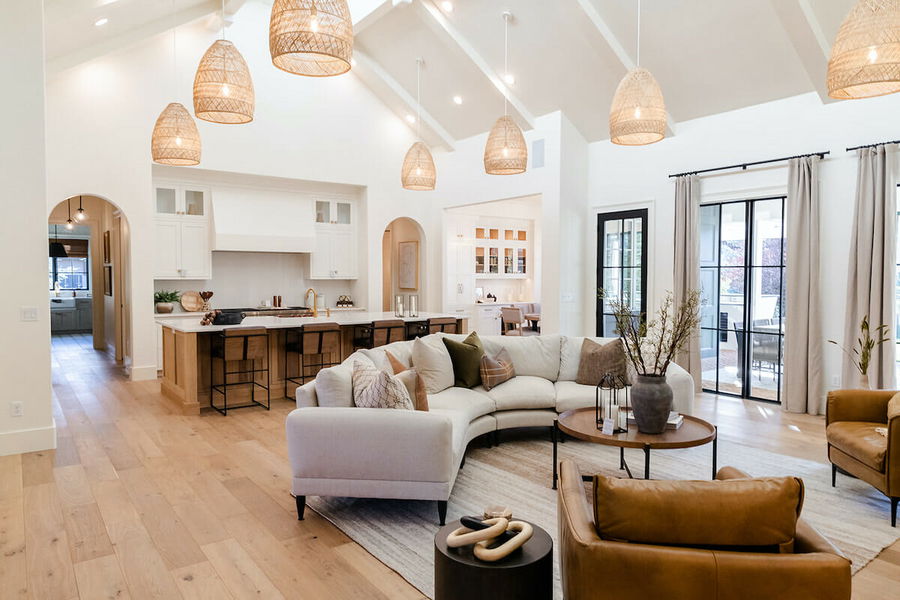14 Common Design Mistakes You Might Be Making

Interior-design experts reveal the style bloopers they see most often and how to banish them from your home forever.
•
Ever wish you had a team of design experts to walk through your home and tell you what doesn’t feel quite right—and why? You’re in luck: Here, nine Denver-area interior designers give us the skinny on common style bloopers and the secrets to banishing them from your rooms forever.
Planning A Room
Ahh, a blank slate. You’ve got a room you’re ready to refresh, and you can’t wait to fill it with beautiful new things: perhaps a Chesterfield sofa, a Danish modern console, or that artwork you’ve had your eye on for two years? Not so fast, our experts say. Here’s where we all tend to misstep before we’ve even chosen a paint color.
Mistake 1: Glossing Over the Layout
“[When we’re hired to do a remodel], we almost always see rooms with all of the elements out of scale”—think: furnishings too small or too big, fixtures the wrong size—says Joey Rheem, marketing director for Studio Thomas. “Clients buy furniture, rugs, and art without creating a floor plan first.” The result: a room that feels disjointed and uninviting.
Fix: Get a plan! You can hire a firm like Studio Thomas to create a floor plan using CAD, or opt for assistance from apps—MagicPlan gets top ratings—or a website such as PlanYourRoom.com.
Mistake 2: Not Prioritizing Function
Fix: While whipping up the aforementioned layout, consider not just how anyone would use the room, but how you need to use it, says Laura Medicus of Laura Medicus Interiors. Your long living room might need to be divided into a cozy seating area by the fireplace and a sleek in-home workspace. Just because someone created a formal dining room doesn’t mean you can’t use it as a playroom off the kitchen. You’re the boss here, so decide how the room will work before you buy a single item.

Mistake 3: Overlooking Millwork
Fix: We’re willing to bet that half the reason you love a room in a magazine is because of the millwork: handsome trim, coffered ceilings, swoon-worthy moldings. Before you buy so much as a throw pillow, consider this: “Different types of millwork can be used to complement almost any design aesthetic and will truly elevate the overall look and feel of the home,” says Kim Blankenburg of Layers & Lines. Need help sorting through the various styles? Check out Metrie, a nearly century-old millwork company with locations nationwide, including in Denver.
Mistake 4: Failing To “Create” Height
Fix: Unless you are literally going to raise the roof, you’ll want to give your room the illusion of height. A few pro tips that draw the eye up: Wallpaper the ceiling, hang the curtains near the very top of the wall (see below for specific tips), opt for vertical wall sconces or a vertical fireplace, and raise the height of your doorways. Plan for these details now to ensure they jibe with your lighting, finishes, and furnishings later.
Lighting & Finishes
Two of a home’s most important design elements are its finishes—permanent, nonstructural components such as stair rails and millwork, countertops and cabinets, flooring and wall treatments—and lighting, because what’s the point of investing in a useful and beautiful space if you can’t see it? Get these elements right, and your home will feel oh-so good.
Mistake 5: Keeping Dinky Stair Rails
“Homes built in the ’90s and early 2000s often have high staircase walls and short, stubby railings that make spaces feel outdated and closed in,” says Blankenburg.
Fix: She recommends lowering the stair wall as close to the treads as possible and installing a clean, modern railing. “It can be designed in a simple and functional way that brings a little personality and sculptural interest to the space,” she says.
Mistake 6: Keeping That “Orange-Peel” Wall Texture
Fix: You’ve got a few options: You can have the walls retextured for a more contemporary look, but that’s a “massive, messy undertaking,” says Molly Bevan of Layers & Lines. (And it’s quite expensive.) Bevan suggests introducing millwork to hide much of the wall texture; alternatively, designer Andrea Schumacher recommends concealing it with a forgiving grasscloth wallcovering.
Mistake 7: Piling on Too Many Finishes and Materials in a Single Space
Fix: Coco Chanel famously advised us all to look in the mirror and remove one accessory before leaving the house, and the same “less is more” philosophy applies to a room’s materials palette. Grab samples of all the hard finishes you’re planning to use then take one of them away—maybe it’s the secondary countertop material; maybe it’s a tile. Odds are, this edit will give your room a more sophisticated feel.
Mistake 8: Picking a “Central” Color, Then Using Too Much of It
Fix: Let us introduce the 60-30-10 rule: Sixty percent of a room’s color palette should be one hue, 30 percent is a secondary hue, and the remaining 10 percent is an accent color. This trick creates depth in the palette because the eye is drawn to the colors used least in the room. So, if you want to show off your love affair with turquoise blue, pick up an accent chair in that color. Easy peasy.

Mistake 9: Relying Too Heavily on Ceiling Light Fixtures
Fix: Like cake, lighting is best when it’s layered. Chris Awadalla of Sanctuary Kitchen & Bath Design says you need sources of overhead or ambient light, task lighting (lamps or fixtures specific to a part of the room), and accent lighting to add drama or set the mood (illuminating artwork, for example). Hot tip: Too many recessed ceiling lights can cause a living space to feel more like a dentist’s office. To avoid this, experts suggest installing one recessed light for every three-and-a-half to five square feet of ceiling space, depending on the height of the ceiling and type of room.
Mistake 10: Hanging a Chandelier Too High or Too Low
Fix: “A rule of thumb is [to hang the light] 30–36 inches above a dining table,” says Seek Interior Design principal Kristina Sterling, who adds that before you order a fixture, you’ll need to figure out how much chain or how long a stem you require. You might need to place a special order or customize your choice to ensure you hit the sweet spot.
Furnishings & Decor
We’ve arrived at everyone’s favorite part: decorating! But if you’ve ever known the particular brand of heartbreak that comes from filling a room with stuff, only to discover that you don’t love it, you know that this step in finishing a space is a landmine of potential design mistakes. Here’s how to sidestep them.
Mistake 11: Displaying Every Piece of Decor You Own
Fix: “We literally go into our clients’ spaces and remove every single thing,” Rheem says. Then, with clients’ help, a Studio Thomas designer sorts these pieces into essential items that should be displayed and items that just need to be discarded or donated. “The impact of editing is incredible,” she says. “Spaces feel completely updated and fresh when the clutter is gone.”
Mistake 12: Buying Furnishings From Only One or Two Sources
“We often see that clients have bought a bed, dresser, and nightstands in the same style and finish, and all from the same store,” says Anna Elyce Smith of Annabode.
Fix: Mix it up! “To make your home feel more collected over time, mix and match your furniture,” Smith says. Stephanie Waddell of Istoria Interiors agrees, noting that replicating styles found in a showroom or catalog can leave a space feeling lackluster. Adding a vintage, antique, or secondhand piece makes a room more interesting.

Mistake 13: Hanging Art Too High
“[We especially see] art or a clock hung above doorways and windows,” Smith says. “Only in certain situations does this make sense; most of the time, it throws off the room’s balance.”
Fix: Aim for eye level—that’s about 60 inches from the center of the work to the floor. “And remember: Just because there’s a spare wall doesn’t mean it needs to be filled,” Smith says. If you have a strong focal point in the room, a few blank spots can give the eye a place to rest.
Mistake 14: Choosing Diminutive Decor
Fix: Size up. Fewer, larger pieces make a room feel more polished than a lot of small elements. If you’re afraid to buy that seemingly giant artwork, cut a piece of cardboard to its dimensions and tape it to the wall where you plan to hang it. You’ll know right away if the size works.
The Experts:
Chris Awadalla, Sanctuary Kitchen & Bath Design
Molly Bevan & Kim Blankenburg, Layers & Lines
Laura Medicus, Laura Medicus Interiors
Joey Rheem, Studio Thomas
Andrea Schumacher, Andrea Schumacher Interiors
Anna Elyce Smith, Annabode
Kristina Sterling, Seek Interior Design
Stephanie Waddell, Istoria Interior Design
Cheat Sheet
Keep these helpful tips on hand for the next time you need to address one of the following surprisingly tricky design tasks.

How To Hang Curtains the Right Way
1. If your curtain rod is too close to your window frame, the rod looks a bit like a furrowed brow—and worse, “steals” height from your room. Instead, hang your rod one-third to two-thirds of the distance between the window frame and ceiling. And, lest you visually shrink the window, be sure the rod extends approximately four to 10 inches beyond the edge of the frame on each side.
2. Make sure your curtains are long enough to reach the floor. If you don’t want the ends of your curtains to dramatically “puddle” (which can be a hassle to clean around), you can float them ever so slightly above the floor.
3. And finally, don’t skimp on the width: You want your curtains to have some softness even when they’re closed—not pulled taut like a button-down shirt on a linebacker. If you have a particularly wide window, you might need two panels on each side to have sufficient fabric for a polished look.
How To Properly Position a Rug

1. Front Legs Only: If you’re a “play-it-safe” type of person, look no further than this go-to setup for your living room rug. Take the furniture layout you designed and pick a rug that’s big enough to slide under the front legs of the sofa, as well as the front legs of all the chairs. You want about one-third of each of these pieces to be on the rug. This foolproof method allows furniture pieces to show their individual personalities while maintaining a cohesive look.
2. All Aboard; Two Layered Rugs; The Float: You’re more of a daredevil? These three styling options may be a little less conventional, but they can be used to make the most of a rug you already have or inherited from your fashionable granny. (We promise: No one will call the rug police.)
How To Choose A Lightbulb

1. First, understand wattage: Maybe you think of wattage as the brightness of the bulb, but it’s actually the amount of energy the bulb uses. Because LED lights are so much more energy-efficient than incandescent versions, the wattage on LED lights is a lot lower. A rule of thumb: Multiply the LED wattage by five to get a sense of a LED bulb’s light output.
2. Learn about lumens: Speaking of brightness, lumens are the real measure of light output. You want about 400 lumens for your bedside lamp, and up to 3,000 total for the light sources in an average-size living room.
3. Meet Kelvin: Light, of course, comes in different colors, and Kelvin measures the warmth or coolness of the light’s hue. Measurements in the 2000s indicate warmer, gold-ish colors, while those near 3,500 represent a neutral, bright white. Bulbs with Kelvins near 6,000 will give off a blue-tinted light. Smart LED lights can change their color across the white-light spectrum. Higher Kelvins help you feel awake in the morning, but a warmer hue is best as the day winds down.
4. Buy the right stuff: If you have a dimmable or three-way fixture, be sure you buy bulbs with packaging that indicates they’re made for such use. Not all bulbs are.










